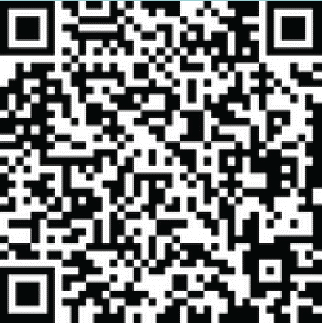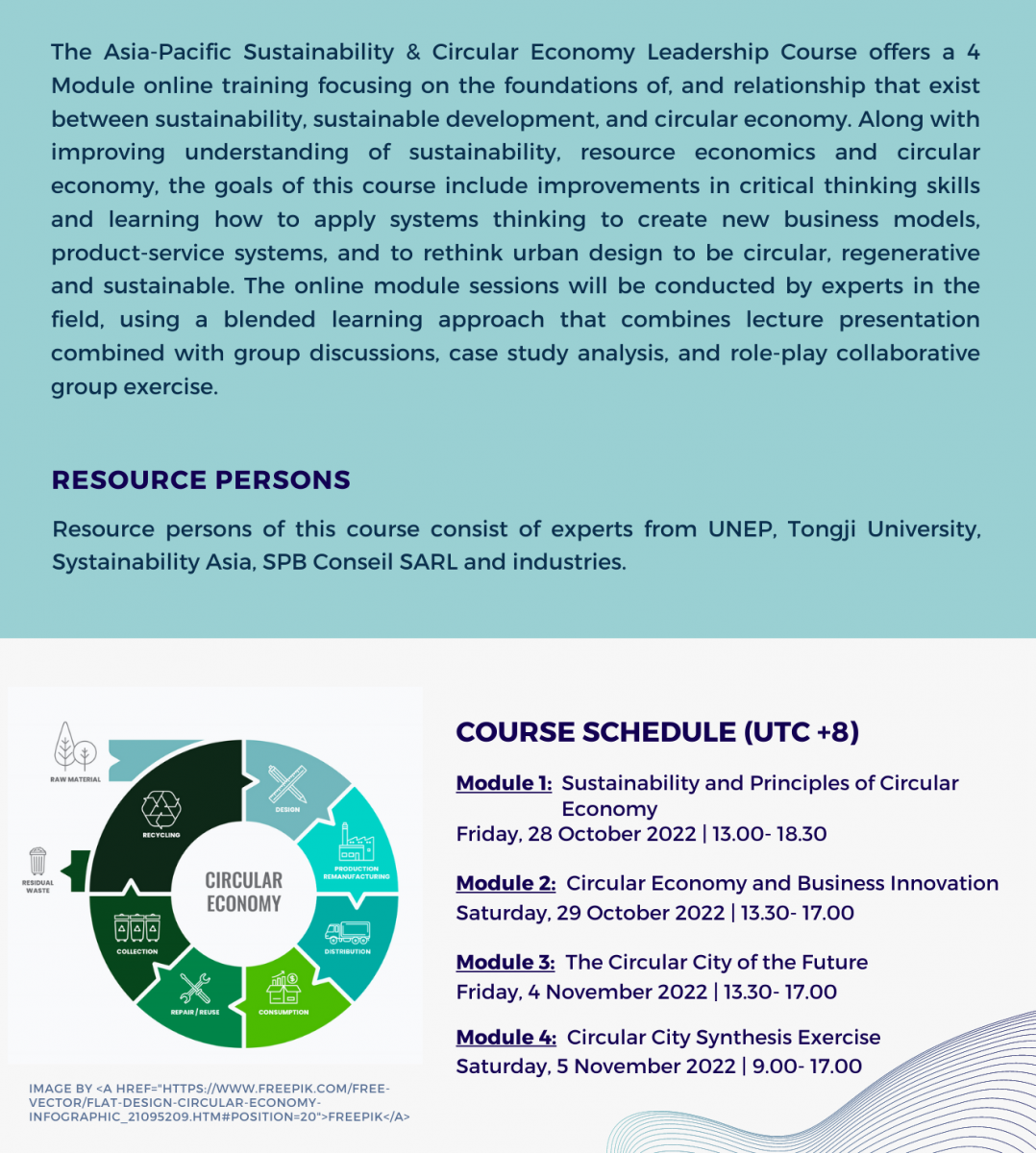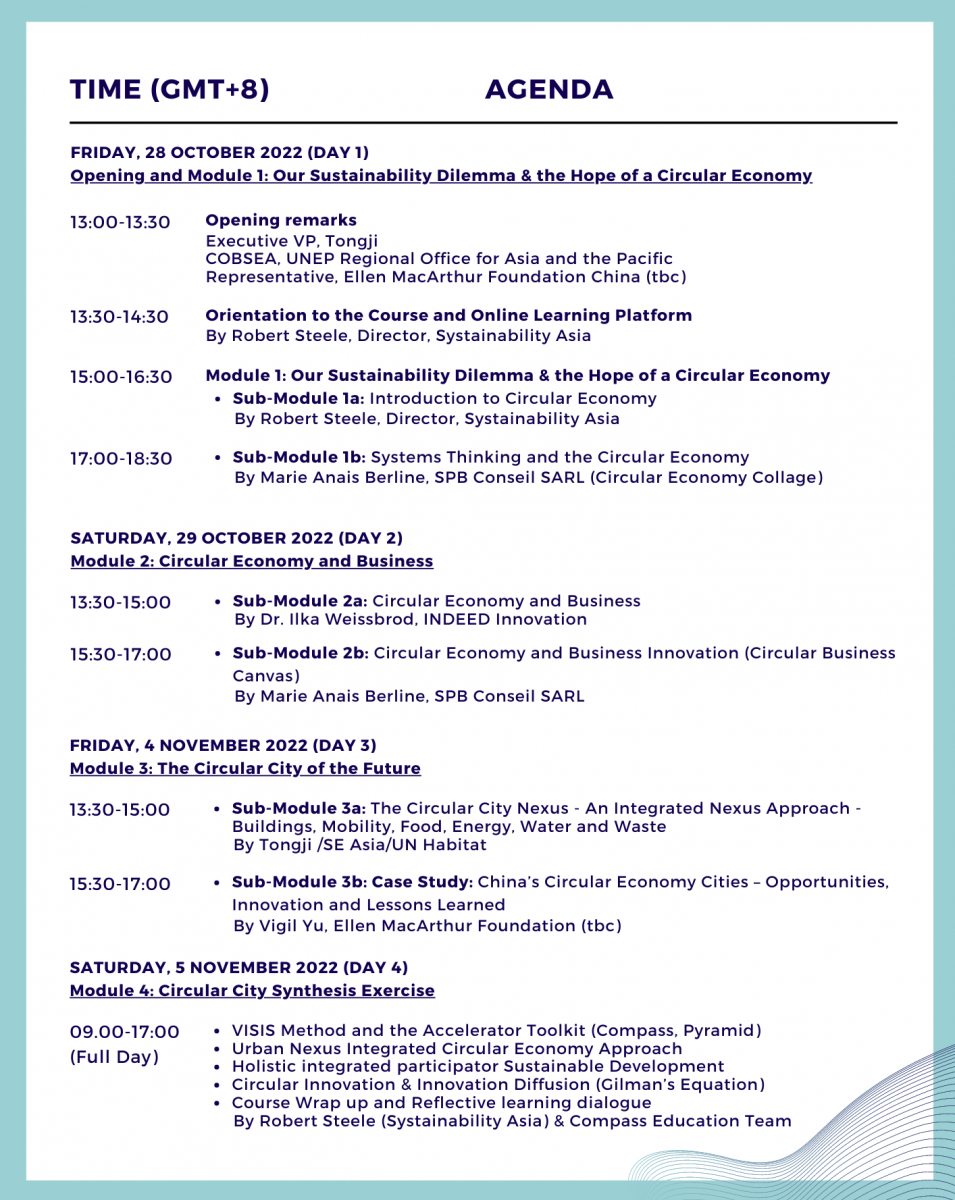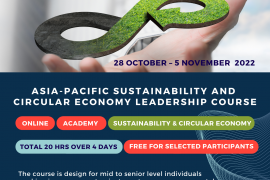EVENTS & NEWS
 Sustainability & Circular Economy
Sustainability & Circular Economy
Title: Asia-Pacific Sustainability and Circular Economy Leadership Course
Date: 28 - 29 October and 4 - 5 November 2022 (Total 20 hours)
Venue: Online
Language: The course will be offered in English.
Certificate: Participants who complete this academy session successfully will receive a Certificate of Completion.
Download Flyer: Click here
Inquiries, please contact:
Systainability Asia: watkana@systainabilityasia.com
IESD: jiaqian@tongji.edu.cn
Application Instructions
- Participants who apply to attend this course should be able to reserve the time for the 4 modules in their entirety. Full participation in all sessions is expected (a certificate of course completion will be issued for participants who complete all modules).
- The number of participants will be around 30.
- The course is fully online, live, and not asynchronous.
- The course will only be available in English language.
- This course does not charge any fee at any stage.
- Please go to the application form and fill out completely and submit.
- Final list of participants will be informed through email in due time.
Apply before 15 October 2022
 or scan here
or scan here 
*This course does not charge any fee at any stage.

Modular Learning Framework
The modules and tools have been developed according to a framework organized in Six main areas:
2. Systems Thinking: Application of systems thinking perspective, concepts and methods in transforming from a linear to a circular approach and mindset;
3. Business: The business value approach required for the success of new, more circular and sustainable products or product-service system delivery;
4. Design: Product and product-service system design according to circularity and environmental sustainability criteria;
5. Urban Circularity & Nexus Approach to waste, water, energy, food, transportation and the built environment;
6. Synthesis: Synthesis of all previous information and learning into a multi-stakeholder circular city blueprint role-play exercise
Learning Outcomes
Knowledge and understanding:1. Can present and discuss knowledge based on the combination of high international level of theory, research and practice, within the following areas:
- Sustainability & Sustainable Development
- Circular economy and circular eco-design
- Life Cycle Thinking & Material Flow
- Development of multi-disciplinary design solutions
- Circular business models and related value creation
- City Circular integrated nexus design
Practical Skills:
- Get acquainted with circular design tools and be able to apply them in product and service design and development
- Become practically familiar with related systems thinking and circular design tools and methods, methods from business and city innovation studies and methods, and can use these to analyze sustainable, circular innovation.
- Engage in constructive dialogue regarding key concepts and models of Sustainability and Circular Economy in the context of the Sustainable Development Goals (SDGs).
- Can critically consider the key principles, theories and methods of circular economy and develop new models and practices for sustainable, circular innovation, and in collaboration with networks of different stakeholders transform these into strategic plans of action.
- Identify the synergies and trade-offs in the Circular Economy that exist between environmental, economic, social and individual human wellbeing aspects in designing for a holistic integrative approach to sustainability.
Course Agenda

Specific Modules
Module 1: Our Sustainability Dilemma & the Hope of a Circular Economy
Module 1 will provide participants with a solid foundation on key knowledge areas of sustainability theory and practice in the face of rapid global change. We will explore the historical trends that makes sustainability such an important goal, and how we as a human society can transform our social and economic system through a circular economy and how it relates to sustainability. Participants will understand the interactions between different system elements using a tool called the Circular Economy Collage.
- Sub-Module 1a: Introduction to Circular Economy
b) be able explain the limits to growth, ecological footprint and overshoot
c) be able to explain the term Anthropocene and what “Biomimicry” is and why it is an important door to sustainability in business and human living;
- Sub-Module 1b: Systems Thinking and the Circular Economy
a) Understand (and be able to explain) the conceptual difference between open and closed systems;
b) Recognize the interdependency of components within a complex system;
c) Understand the relationship between events, patterns and system behavior.
Module 2: Circular Economy and Business
Module 2 focuses on the application of Circular Economy to business. We will learn about how businesses can create value in a circular economy. The butterfly diagram will be revisited and we will investigate value creation and new business models in the Circular Economy. We also will spend some time on exploring three main business processes required to close loops and participants will have a role play experience to look at product life extension through the eyes of designers and entrepreneurs. Finally, this module will provide a very interactive exercise using “Circular Canvas” tool, to create the outline of a business model and design a solution to meet the needs of a company.
- Sub-Module 2a: Circular Economy and Business
a) Learn about and be familiar with the business approach required for the success of new, more circular and sustainable products or product-service
b) Through the butterfly diagram, explain how we can capture value from longer-lasting products, through maintenance, reuse and redistribution.
c) Understand the role of design and designers in the circular economy model
- Sub-Module 2b: Circular Economy and Business Innovation (Circular Business Canvas)
a) have an opportunity to participate in short hands-on exercises using the Circular Canvas tool.
b) learn about value chain mapping and how it can foster the understanding and implementation of circular design principles;
c) draft a business model with a focus on sustainability and circularity.
Module 3: The Circular City of the Future
Module 3 will first have participants look critically as how our traditional city models are causing and/or exacerbating global sustainability crisis. They will then investigate how cities of the future can become models of sustainability through embracing a circular economy model by ESG approach. We will discovery how these cities are also magnets for creative innovation potential. There will be a case study exercise analyzing China's experience in their early pioneering of circular economy at scale and its evolution to current practice, focusing on urban and industrial innovation and impact investing.
- Sub-Module 3a: The Circular City Nexus - An Integrated Nexus Approach - Buildings, Mobility, Food, Energy, Water and Waste
a) Understand what are the impacts that cities have on the climate change, pollution, biodiversity loss, social cohesion and human health.
b) Understand the nexus between the built environment with mobility, energy, agriculture (food), waste and water supply system and what are the considerations that are needed for optimal policy outcome in.
c) Investigate different approaches to urban circularity.
- Module 3b: Case Study: China’s Circular Economy Cities – Opportunities, Innovation and Lessons Learned
a) Understand the key components of China’s circular economy model;
b) Know the underlying reasons for why China was an early pioneer in Circular Economy adopted;
c) Understand the policy landscape that supports China’s Circular Economy approach and strategy;
Module 4: Circular City Synthesis Exercise
In the transition towards the building of sustainable urban communities that incorporate the principles circular economy, effective participatory tools and methods will play an important role, especially for getting stakeholder participation, understanding, ownership, and eventual buy-in, to what is being proposed by policy makers, urban planners, business leaders and technocrats. In the finale Module, participants will have an opportunity to participate in an online collaborative urban circular economy system design exercise. You will design a multistakeholder sustainable circular city initiative, using the Sustainability Accelerator toolkit developed by Alan AtKisson.
Learning Objectives:
a) Co-create with other participants an integrated Circular Economy Blueprint for an Asian city scenario that links with and contributes to the SDGs;
b) Frame their sustainable circular city through the Compass of Sustainability (Nature, Economy, Society and Wellbeing);
c) experience the importance and challenges of facilitating multi stakeholder network collaboration supporting circular economy
ORGANIZERS
IESD
The Institute of Environment for Sustainable Development (IESD), was jointly established by United Nations Environment Programme (UNEP) and Tongji University in 2002, as interdisciplinary platform for education and research, with a focus on the global south.
Systainability Asia
A multi-disciplinary Asia regional consultancy that works closely with national and regional government institutions, international development agencies, private sector companies and education institutions in the Asia-Pacific region to build capacity and find long-term solutions to the sustainability challenges we face.





